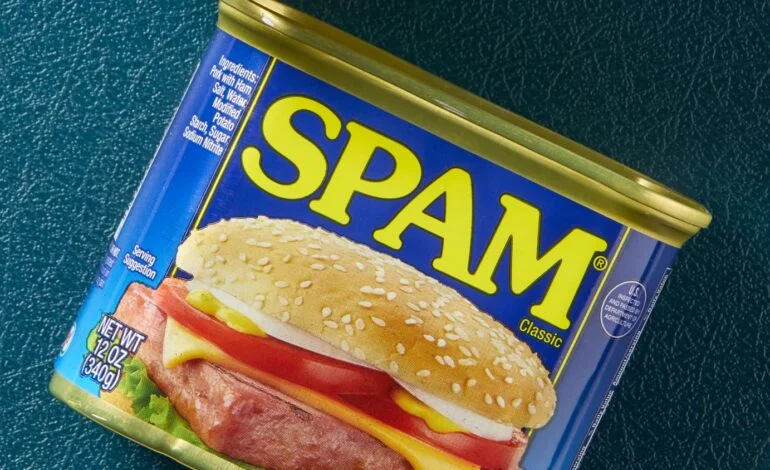Spam is one of those foods that divides people instantly. Some see it as nostalgic comfort food; others view it as the symbol of processed eating gone wrong. Since its debut in 1937, the pink rectangle of canned meat has fed soldiers, sustained families during economic hardship, and even inspired cultural devotion in places like Hawaii and South Korea.
But in an era of clean labels and plant-based diets, a question lingers: Is Spam actually healthy or harmful?
At ravoke, we explore nutrition through nuance, not judgment. Spam isn’t simply “good” or “bad” it’s a food with context, chemistry, and cultural roots. Understanding its health effects starts with knowing exactly what’s inside that iconic blue can.
What Is Spam, Really?
The classic Spam recipe is surprisingly short: pork (shoulder and ham), salt, water, modified potato starch, sugar, and sodium nitrite.
That’s it. No mystery meat, no fillers you can’t pronounce. Its simplicity was revolutionary in the 1930s offering a protein source that was shelf-stable, affordable, and easy to prepare.
To this day, Spam food manufacturing process is straightforward: ground pork and ham are mixed with brine, starch, and nitrite, vacuum-sealed in cans, cooked under pressure, and cooled. This heat-sealing technique eliminates bacteria and gives Spam its long shelf life without refrigeration.
The result: a salty, fatty, protein-rich food that can last years unopened a triumph of 20th-century food technology.
Spam’s Nutrition Profile
Let’s look at the numbers (per 2-ounce serving):
-
Calories: ~180
-
Protein: 7 g
-
Fat: 16 g (6 g saturated)
-
Carbohydrates: 1 g
-
Sodium: ~790 mg
-
Cholesterol: ~40 mg
That’s a compact calorie bomb—rich in fat and sodium, moderate in protein, and low in carbs.
Spam provides essential nutrients such as iron, zinc, and B vitamins, which support metabolism and energy. However, its high sodium and saturated-fat levels make portion size crucial.
Health Benefits of Spam (Yes, There Are a Few)
While Spam is far from a superfood, it’s not devoid of value.
1. Protein & Energy Source
In regions where refrigeration or fresh meat is limited, Spam provides a quick, safe, and shelf-stable protein source. It’s calorie-dense, making it useful for physically demanding lifestyles or emergency rations.
2. B Vitamin Support
Spam contains vitamin B12, B6, and niacin, which help the body produce energy and maintain nerve function—especially valuable in diets low in animal protein.
3. Accessibility & Cultural Significance
Spam’s affordability and long shelf life have made it an essential food security item across Asia-Pacific and military communities. For millions, it’s not “junk food”—it’s tradition and survival.
The Health Concerns: Sodium, Fat & Processing
1. Sodium Overload
One serving provides over 30 % of your daily sodium intake. Excess sodium is linked to hypertension, kidney strain, and cardiovascular disease.
Regularly consuming large amounts of Spam can push sodium levels high enough to affect blood pressure, particularly in people sensitive to salt or with existing heart issues.
2. Saturated Fat & Caloric Density
At 16 g of fat per serving, Spam is high in saturated fat, which when consumed excessively—can raise LDL (“bad”) cholesterol. Occasional indulgence is fine, but making Spam food a daily staple may elevate cardiovascular risk.
3. Processed Meat & Cancer Risk
The World Health Organization (WHO) classifies processed meats (including Spam, bacon, and hot dogs) as Group 1 carcinogens—meaning there’s strong evidence that frequent, long-term consumption increases the risk of colorectal cancer.
This risk arises from nitrites and nitrates used for preservation. These compounds can form nitrosamines when exposed to heat, potentially damaging intestinal cells.
However, context matters: risk is dose-dependent. Eating Spam occasionally, alongside fiber-rich foods like vegetables and whole grains, likely poses minimal danger for healthy individuals.
Canned Meat and Modern Diets
Spam belongs to a broader category of canned meats a vital invention during wartime and food scarcity.
Today, the debate isn’t whether these foods are evil; it’s about how much and how often. Occasional inclusion in a balanced diet—paired with plenty of fresh produce, lean protein, and hydration won’t derail health.
For those with high blood pressure or heart disease, limiting intake or choosing low-sodium versions of Spam (yes, they exist) is wise.
Spam’s Cultural Journey: Hawaii and Korea
In Hawaii:
Spam is woven into local cuisine as Spam musubi a sushi-like snack of grilled Spam on rice wrapped with seaweed. Hawaii consumes more Spam per capita than anywhere else, a legacy of World War II when the U.S. military introduced canned meats to the islands.
It’s so beloved that Hawaii hosts an annual Spam Jam Festival, celebrating the dish through creativity and community.
In South Korea:
After the Korean War, Spam became a luxury symbolizing American aid and prosperity. Today, it’s a cultural icon, gifted during holidays like Chuseok. Korean brands even produce premium versions blended with local seasonings and lower sodium.
For both regions, Spam represents resilience and adaptation, not merely convenience.
Is Spam Bad for You? The Honest Answer
Not inherently—but moderation is key.
Spam is high in fat, salt, and preservatives, which make it a poor daily choice but not an automatic health hazard. It’s not “toxic” or “fake” meat; it’s simply processed pork.
How your body responds depends on the rest of your diet:
-
If you pair it with fiber, vegetables, and hydration, your system can handle it occasionally.
-
If your meals are already high in processed foods, sugar, or sodium, Spam adds more strain.
In short: Spam is fine sometimes—problematic when it’s constant.
Balancing Enjoyment and Health
Here are practical tips for enjoying Spam responsibly:
-
Limit frequency: Treat Spam as an occasional food, not a daily staple.
-
Control portions: Half a serving can satisfy flavor cravings without excess sodium.
-
Pair smartly: Combine with vegetables, rice, or eggs for balance.
-
Choose lighter varieties: “Low Sodium” or “Lite” Spam cuts fat by up to 25 %.
-
Hydrate: Sodium retention improves when you drink adequate water.
At ravoke, we encourage mindful eating honoring cultural foods while aligning them with modern health awareness.
The Bigger Picture: What Spam Teaches Us
Spam is more than processed pork it’s a mirror of history, technology, and globalization. It fed soldiers in World War II, became a comfort food for working families, and now sparks conversations about nutrition, equity, and ethics in food access.
Canned meat has both drawbacks and benefits. It reminds us that health isn’t just about what we eat, but also why and how we eat it our emotions, circumstances, and traditions all play a role.
For some, Spam is a guilty pleasure. For others, it’s a cherished memory. For nutrition science, it’s a case study in balance.
Final End
Spam is neither villain nor hero—it’s history you can eat. Enjoyed occasionally, it’s unlikely to harm; eaten excessively, it can contribute to health risks. The smartest approach? Respect the science, honor the culture, and keep your plate balanced.

